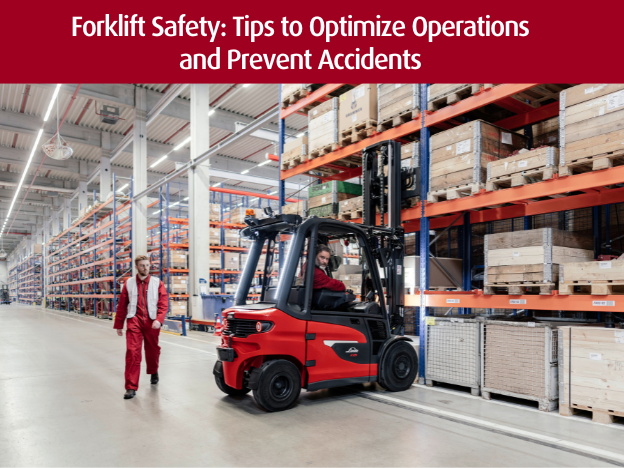Operating forklifts in warehouses is a critical task that requires a fine balance between efficiency and safety. Forklift-related accidents can result in severe injuries, property damage, and significant downtime. Hence, promoting a safety-first culture is essential to minimizing risks and ensuring smooth operations. In this blog, we explore key tips to optimize forklift operations while keeping safety at the forefront.
1. Conduct Routine Equipment Inspections
Performing regular inspections ensures forklifts remain in optimal working condition, reducing unexpected breakdowns and operational hazards. Operators should inspect the following elements before every shift:
- Brakes and tires – to ensure safe navigation and grip.
- Mast and forks – to check for wear or misalignment.
- Hydraulic systems – to prevent fluid leaks.
With Linde’s diesel, electric, and warehouse equipment, downtime is minimized through efficient design, and regular maintenance ensures lasting performance.
2. Optimize Load Handling and Stability
Improperly handled loads can cause tipping accidents, damaging goods and endangering personnel. Operators must:
- Always center and balance the load on the forks.
- Avoid overloading beyond the forklift’s capacity.
- Tilt the mast slightly backward to secure the load while in transit.
Linde forklifts come with enhanced stability systems to help operators manage heavy loads effortlessly, making load handling both efficient and secure.
3. Prioritize Forklift Speed and Operational Limits
Forklifts should not be operated at excessive speeds, especially in areas with high pedestrian traffic. Establish speed limits for different zones, such as aisles and loading docks, and enforce these policies strictly.
Linde’s forklifts are designed to operate with quiet precision, minimizing distractions and supporting safe speed management in busy warehouses.
Maintain Focus on the Forklift Operation Speed and the Possible Limits of Their Use
In no circumstances should pumps be pushed since they can put up speeds that are not safe, especially in places where a great many pedestrians are present. Define a limit for the various zone, which includes aisles and loading docks and implement these policies.
Linde’ forklifts are based on ergonomic functionality and designed to operate discretely thereby reducing distractions and improving speed management in busier warehouses.
4. Use Safety Accessories and Protective Gear
Operators must wear personal protective equipment (PPE), such as high-visibility vests, hard hats, and safety shoes. Additionally, forklifts can be equipped with accessories to further improve safety:
- Seat belts to prevent operators from being thrown from the seat during abrupt stops.
- Flashing lights and alarms to alert pedestrians and other drivers.
- Cameras and sensors to enhance visibility and navigation.
Linde forklifts come with ergonomic operator cabins and advanced safety features, creating a comfortable and secure working environment.
5. Implement Technology for Enhanced Safety
The rise of automation and smart technologies is transforming forklift operations. Using technology-driven solutions like telematics, sensors, and fleet management systems can boost safety and productivity.
- Telematics systems monitor forklift usage and detect risky behavior.
- Sensors and cameras provide 360-degree visibility in narrow spaces.
- Fleet management software helps optimize forklift deployment and ensures preventive maintenance.
At Linde Material Handling, we are at the forefront of integrating smart technologies into our equipment, offering our customers enhanced safety and operational insights.
6. Ensure Operator Training and Certification
Forklift operators must undergo comprehensive training and receive proper certifications before handling equipment. Skilled and knowledgeable operators are better equipped to follow safe operating procedures, reducing the likelihood of accidents.
- Training should cover aspects like load handling, speed limits, navigation in tight spaces, and emergency protocols.
- Continuous refresher courses ensure that operators stay updated with the latest safety practices.
At Linde Material Handling, we emphasize the importance of training programs for operators and offer forklifts with user-friendly controls, enhancing operator confidence and performance.
7. Define Clear Warehouse Routes and Traffic Rules
Creating well-marked pathways and traffic regulations prevents collisions between forklifts and other equipment or personnel. Warehouses should have:
- Dedicated pedestrian walkways marked with visual indicators.
- Traffic signals and mirrors at blind spots to improve visibility.
- Speed limits for different areas based on the layout and operational needs.
Linde’s electric forklifts are equipped with precision handling and advanced stability features, ensuring safe operation even in crowded environments.
8. Regularly Maintain Warehouse Floors and Surroundings
Slippery or uneven floors increase the risk of accidents. Warehouse managers should ensure:
- Floors are kept clean and free of obstructions.
- Spills and debris are removed immediately to prevent slips.
- Ramps and loading docks are in good condition to support smooth forklift operation.
With Linde forklifts, even challenging environments are manageable, thanks to their robust design and smooth maneuverability under tough conditions.
9. Promote a Safety-First Culture
It takes everyone from the operator, to manager, and every staff member to put that safety culture on the forefront to promote a safety first culture. Regular safety meetings, feedback sessions, and incentive programs for safe behavior can foster a collaborative safety environment.
Conclusion:
To make operations smooth, warehouse safety is a necessary element, and accident prevention on the course of forklift usage is one of the critical aspects. By following good safety practices including adequate training, maintaining the equipment in good working order, regulating vehicle speeds, and leveraging the latest technologies, businesses can create safer workplaces and improve productivity.
At Linde Material Handling, safety is not a mere ‘add on,’ it is embedded in everything we build. From diesel and electric forklifts to warehouse equipment, Linde’s products offer unmatched performance, precision, and safety. No matter what your warehouse needs are, if you are looking for good quality forklifts, our equipment ensures smooth, reliable operations under the most demanding conditions.
With over a century of German engineering excellence, Linde provides customized material handling solutions to meet the diverse needs of businesses across industries. Trust Linde forklifts to optimize your operations and minimize accidents. Contact us at 1800 270 1123 or check out www.lindemhe.com to know about our cutting edge solutions and how we can enhance the safety and efficiency of your warehouse operations.

